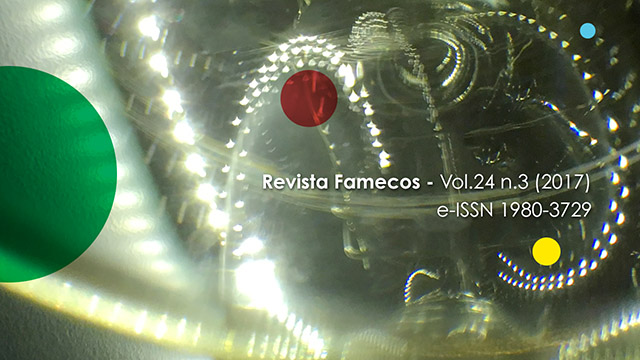Oscar Wilde’s Salome: Veils, mirrors and beheading in the Belle Époque
DOI:
https://doi.org/10.15448/1980-3729.2017.3.26065Keywords:
Mirror, Beheading, Modern cultureAbstract
At the end of the 19th century, people could attend to the biblical theme of Salome and the beheading of John the Baptist, that generated an obsessive proliferation in Western culture. The dissemination of this episode in a secular modernity resonates some topics introduced in European thought, such as desire, sexuality, the crisis of identity and of the self’s supposed unity. Based on Nietzsche’s “power of the false”, this essay explores Oscar Wilde’s Salome and the interplays it establishes between veils/masks and mirrors. It also analyses some passages of the play which emphasize the dangers of direct gaze and of the drives that led modern subjectivities to “lose their heads”.
Downloads
References
BATAILLE, Georges. Soleil pourri. Documents n. 3: Hommage à Picasso, Paris, 1930. Disponível em: http://www.pilefacebis.com/sollers/IMG/pdf/Documents%202-3%20Hommage%20a%20Picasso.pdf. Acesso em: 10 dez. 2016.
CASTRO, Eduardo Viveiros. O medo dos outros. Revista de Antropologia, São Paulo, USP, v. 54, n. 2, 2011.
DELEUZE, Gilles. Lógica do sentido. São Paulo: Perspectiva, 2011.
FERRAZ, Maria Cristina Franco. Homo deletabilis: Corpo, percepção, esquecimento – do século XIX ao XXI. Rio de Janeiro: Garamond, 2010.
______. Platão: As artimanhas do fingimento. Rio de Janeiro: Ediouro, 2009.
______. Nove variações sobre temas nietzschianos. Rio de Janeiro: Relume Dumará, 2002.
FOUCAULT, Michel. História da sexualidade I: A vontade de saber. Rio de Janeiro: Edições Graal, 2006.
______. História da sexualidade II: O uso dos prazeres. Rio de Janeiro: Edições Graal, 1998.
GIL, José. Metafenomenologia das invejas: magia e política. In: LINS; Daniel; PELBART Peter Pál (Org.). Nietzsche e Deleuze – bárbaros, civilizados. São Paulo: Annablume, 2004.
JANES, Regina. Losing our heads. New York: New York University Press, 2005.
MARCUSE, Herbert. Eros e civilização. Rio de Janeiro: Zahar Editores, 1975.
MORAES, Eliane Robert. O corpo impossível. São Paulo: Iluminuras, 2012.
NIETZSCHE, Friedrich. A gaia ciência. São Paulo: Companhia das Letras, 2012.
NOCHLIN, Linda. The body in pieces. London: Thames & Hudson, 2001.
PENNAFORT, Onestaldo. O festim, a dança e a degolação. Rio de Janeiro: Livraria São José, 1960.
PLATÃO. A república. São Paulo: Edipro, 2014.
POE, Edgar Allan. O homem da multidão. In: ______. Histórias extraordinárias. São Paulo: Companhia das Letras, 2008.
SENNETT, Richard. O declínio do homem público. Rio de Janeiro: Record, 2014.
SIBILIA, Paula. A nudez autoexposta na rede: Deslocamentos da obscenidade e da beleza? Cadernos Pagu, Campinas, n. 44, p. 171-198, jun. 2015.
______. O que é obsceno na nudez? Entre a Virgem medieval e as silhuetas contemporâneas. Revista FAMECOS, Porto Alegre, v. 21, n. 1, p. 24-55, jan./abr. 2014. DOI: https://doi.org/10.15448/1980-3729.2014.1.14753.
SINGER, Ben. Modernidade, hiperestímulo e início do sensacionalismo popular. In: CHARNEY, Leo; SCHWARTZ, Vanessa (Org). O cinema e a invenção da vida moderna. São Paulo: Cosac & Naify, 2001.
VERNANT, Jean-Pierre. Com a morte nos olhos. Rio de Janeiro: Jorge Zahar Editor, 1988.
WILDE, Oscar. Salomé. South Australia: University of Adelaide, 2014.
Downloads
Published
How to Cite
Issue
Section
License
Copyright
The submission of originals to Revista Famecos implies the transfer by the authors of the right for publication. Authors retain copyright and grant the journal right of first publication. If the authors wish to include the same data into another publication, they must cite Revista Famecos as the site of original publication.
Creative Commons License
Except where otherwise specified, material published in this journal is licensed under a Creative Commons Attribution 4.0 International license, which allows unrestricted use, distribution and reproduction in any medium, provided the original publication is correctly cited.






